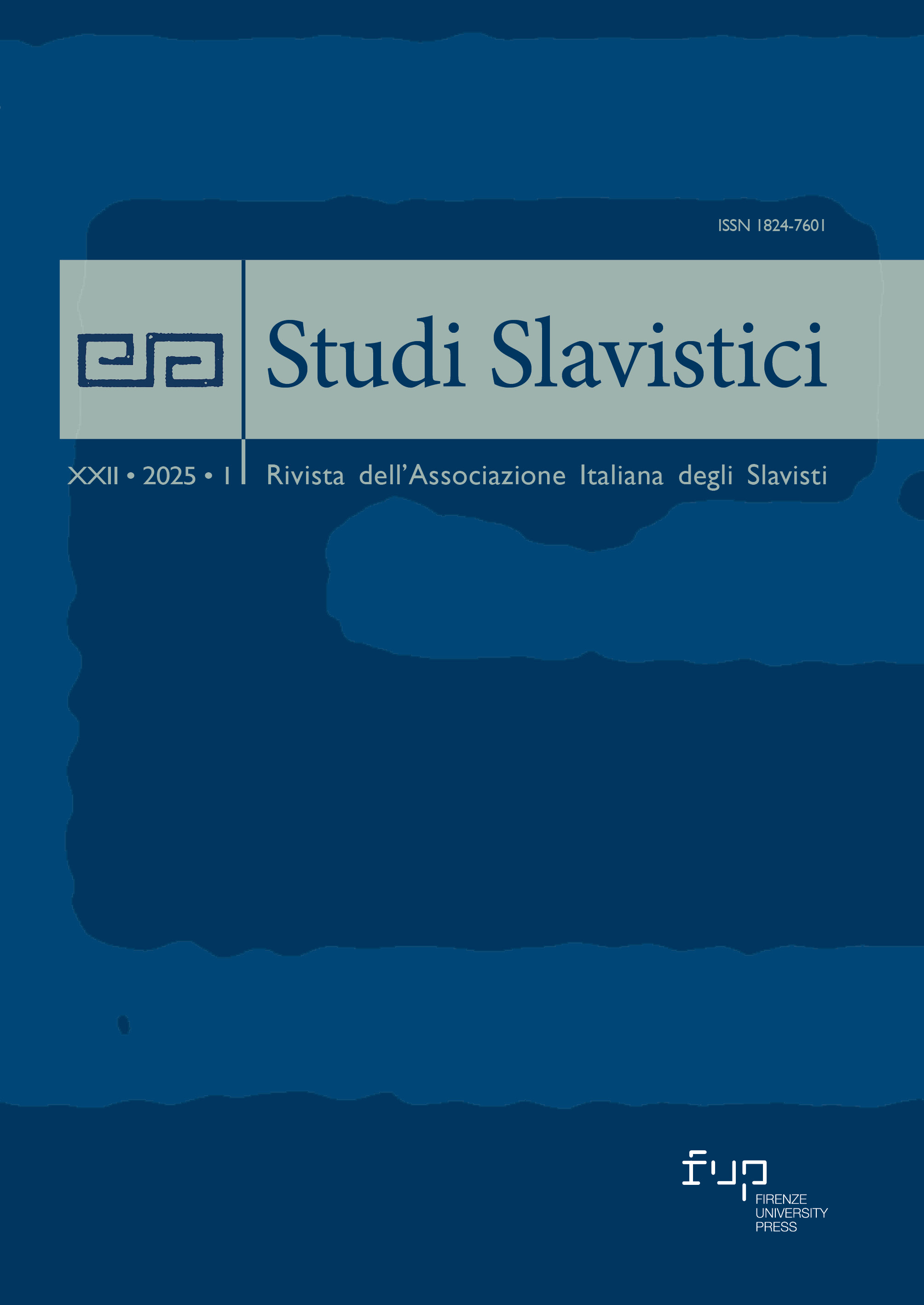Published 2025-07-18
Keywords
- Verbal Aspect,
- Periphrasis,
- Italian-Russian Contrastive Analysis,
- Italian-Russian Parallel Corpus
Copyright (c) 2025 Francesca Biagini, Lucyna Gebert

This work is licensed under a Creative Commons Attribution 4.0 International License.
Abstract
This contribution focuses on the realization in Russian of certain Italian aspectual periphrases – (in)cominciare/iniziare a, continuare a, cercare/tentare di using data from the Russian-Italian parallel corpus of the National Corpus of the Russian Language (nkrja). The theoretical framework adopted is based on the idea that the choice of aspectual forms in Slavic languages is determined by the lexical or actional classes of verbs: the natural, prototypical forms of telic verbs (achievements and accomplishments) are perfective, whereas those of atelic verbs (states and activities) are imperfective. Conversely, the forms of the opposite aspect activated for each class represent marked, peripheral choices with respect to the prototype. The comparison of the Italian periphrases with equivalent Russian verbal forms extracted from the corpus shows that they often correspond to simple aspectual forms in Russian, which quite systematically represent peripheral aspectual choices. As a result, Italian periphrases corresponding to Russian marked aspectual forms explicitly convey the additional semantic load that differentiates them from their unmarked, prototypical counterparts. Since Russian aspectual forms are synthetic and polysemous, the presence of periphrases with the hypothesized semantic value in Italian supports the validity of the adopted theoretical framework.
References
- Andersen, Shirai 1996: R.W. Andersen, Y. Shirai, Primacy of Aspect in First and Second Language Acquisition: The Pidgin/Creole Connection, in: W. C. Ritchie, T. K. Bhatia (eds.), Handbook of Second Language Acquisition, San Diego (ca) 1996, pp. 527-570.
- Bertinetto 1986: P.M. Bertinetto, Tempo, Aspetto e Azione nel verbo italiano: il sistema dell’indicativo, Firenze 1986.
- Bertinetto 1991: P.M. Bertinetto, Il verbo, in L. Renzi, G. Salvi (a cura di), Grande grammatica italiana di consultazione, ii, Bologna 1991, pp. 13-162.
- Biagini 2023: F. Biagini, Gli equivalenti russi della perifrasi verbale imminenziale italiana stare per, “mediAzioni”, xxxvi, 2023, pp. a46-a64, cfr. <https://doi.org/10.6092/issn.1974-4382/16306>.
- Cerruti 2011: M.S. Cerruti, Strutture perifrastiche (Perifrastiche, strutture), in: Enciclopedia dell’italiano (EncIt). Istituto della Enciclopedia italiana Giovanni Treccani, <https://www.treccani.it/enciclopedia/strutture-perifrastiche_(Enciclopedia-dell’Italiano)/> (ultimo accesso: 06.12.2024).
- Comrie 1976: B. Comrie, Aspect, Cambridge 1976.
- Garey 1957: H.B. Garey, Verbal Aspects in French, “Language”, xxxiii, 1957, pp. 91-110.
- Gebert 1991: L. Gebert, Il Sintagma verbale, in: F. Fici Giusti, L. Gebert, S. Signorini (a cura di), La lingua russa: storia, struttura, tipologia, Roma 1991, pp. 237-294.
- Gebert 1995: L. Gebert, Imperfectives as Expression of States, in: P.M. Bertinetto, V. Bianchi, O. Dahl, M. Squartini (eds.), Temporal Reference: Aspect and Actionality, ii (Typological Perspectives), Torino 1995, pp. 79-94.
- Gebert 2009: L. Gebert, Scelta aspettuale ‘oggettiva’ e ‘soggettiva’ e l’imperfettivo fattivo, in: L. Gebert, M. Załęska (a cura di), Linguistica polacca in Italia. Linguistica italiana in Polonia, Pisa 2009 (= “Studi Italiani di Linguistica Teorica e Applicata”, xxxiii, 3), pp. 493-502.
- Gebert 2014: L. Gebert, Aspetto verbale, compiutezza ed implicazioni didattiche, in: A. Bonola, P. Cotta Ramusino, L. Goletiani (a cura di), Studi italiani di linguistica slava: strutture, uso e acquisizione, Firenze 2014, pp. 319-333.
- Hopper, Thompson 1980: P. Hopper, S. Thompson, Transitivity in Grammar and Discourse’, “Language”, LVI, 1980, pp. 251-299.
- Maslov 2004: Ju.S. Maslov, Vid i leksičeskoe značenie glagola v sovremennom russkom literaturnom jazyke, in: Id., Izbrannye Trudy. Aspektologija. Obščee jazykoznanie, Moskva 20042 (19481), pp. 71-90.
- Padučeva 1996: E.V. Padučeva, Semantičeskie issledovanija, Moskva 1996.
- Padučeva 2009: E.V. Padučeva, Semantika vida i točka otščëta, in: Ead., Stat’i raznych let, Moskva 2009, pp. 375-393.
- Plungjan, Rakhilina 2017: V. A. Plungjan, E.V. Rakhilina, Grammaticalization and Coercion: The Case of Russian bez konca, in: A. Makarova, S. Dickey, D. Divjak (eds.), Each Venture a New Beginning: Studies in Honour of Laura A. Janda, Bloomington (in) 2017, pp. 297-311.
- Rosch 1973: E. H. Rosch, On the Internal Structure of Perceptual and Aemantic Categories, in: T.E. Moore (ed.), Cognitive Development and the Acquisition of Language, New York 1973, pp. 111-144.
- Serianni 2015: L. Serianni, Italiano, Milano 2015.
- Squartini 1998: M. Squartini, Verbal Periphrases in Romance: Aspect, Actionality, and Grammaticalization, Berlin-Boston 1998, doi: <https://doi.org/10.1515/9783110805291>.
- Townsend 2001: Ch.E. Townsend, An Approach to Describing and Teaching Slavic Verbal Aspect and the Lexicon, “Journal of Slavic Linguistics”, viii, 2001, pp. 171-183.
- Vendler 1967: Z. Vendler, Verbs and Times, in: Linguistics in Philosophy, Ithaca (ny) 1967, pp. 97-121.
- Zaliznjak, Šmelev 2000: A.A. Zaliznjak, A.D. Šmelev, Vvedenie v russkuju aspektologiju, Moskva 2000.

